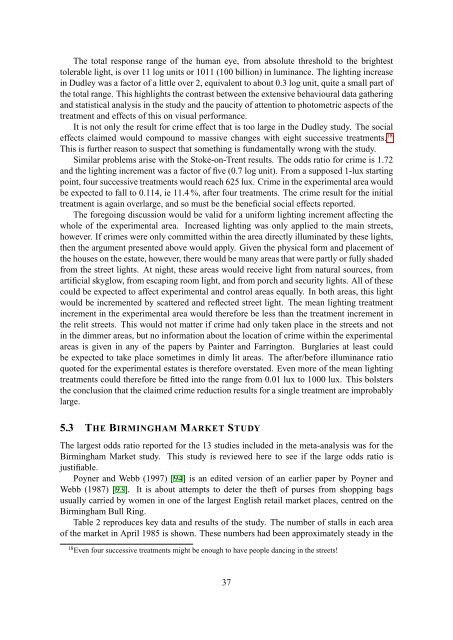outdoor lighting and crime, part 1 - Astronomical Society of Victoria
outdoor lighting and crime, part 1 - Astronomical Society of Victoria
outdoor lighting and crime, part 1 - Astronomical Society of Victoria
Create successful ePaper yourself
Turn your PDF publications into a flip-book with our unique Google optimized e-Paper software.
The total response range <strong>of</strong> the human eye, from absolute threshold to the brightest<br />
tolerable light, is over 11 log units or 1011 (100 billion) in luminance. The <strong>lighting</strong> increase<br />
in Dudley was a factor <strong>of</strong> a little over 2, equivalent to about 0.3 log unit, quite a small <strong>part</strong> <strong>of</strong><br />
the total range. This highlights the contrast between the extensive behavioural data gathering<br />
<strong>and</strong> statistical analysis in the study <strong>and</strong> the paucity <strong>of</strong> attention to photometric aspects <strong>of</strong> the<br />
treatment <strong>and</strong> effects <strong>of</strong> this on visual performance.<br />
It is not only the result for <strong>crime</strong> effect that is too large in the Dudley study. The social<br />
effects claimed would compound to massive changes with eight successive treatments. 18<br />
This is further reason to suspect that something is fundamentally wrong with the study.<br />
Similar problems arise with the Stoke-on-Trent results. The odds ratio for <strong>crime</strong> is 1.72<br />
<strong>and</strong> the <strong>lighting</strong> increment was a factor <strong>of</strong> five (0.7 log unit). From a supposed 1-lux starting<br />
point, four successive treatments would reach 625 lux. Crime in the experimental area would<br />
be expected to fall to 0.114, ie 11.4 %, after four treatments. The <strong>crime</strong> result for the initial<br />
treatment is again overlarge, <strong>and</strong> so must be the beneficial social effects reported.<br />
The foregoing discussion would be valid for a uniform <strong>lighting</strong> increment affecting the<br />
whole <strong>of</strong> the experimental area. Increased <strong>lighting</strong> was only applied to the main streets,<br />
however. If <strong>crime</strong>s were only committed within the area directly illuminated by these lights,<br />
then the argument presented above would apply. Given the physical form <strong>and</strong> placement <strong>of</strong><br />
the houses on the estate, however, there would be many areas that were <strong>part</strong>ly or fully shaded<br />
from the street lights. At night, these areas would receive light from natural sources, from<br />
artificial skyglow, from escaping room light, <strong>and</strong> from porch <strong>and</strong> security lights. All <strong>of</strong> these<br />
could be expected to affect experimental <strong>and</strong> control areas equally. In both areas, this light<br />
would be incremented by scattered <strong>and</strong> reflected street light. The mean <strong>lighting</strong> treatment<br />
increment in the experimental area would therefore be less than the treatment increment in<br />
the relit streets. This would not matter if <strong>crime</strong> had only taken place in the streets <strong>and</strong> not<br />
in the dimmer areas, but no information about the location <strong>of</strong> <strong>crime</strong> within the experimental<br />
areas is given in any <strong>of</strong> the papers by Painter <strong>and</strong> Farrington. Burglaries at least could<br />
be expected to take place sometimes in dimly lit areas. The after/before illuminance ratio<br />
quoted for the experimental estates is therefore overstated. Even more <strong>of</strong> the mean <strong>lighting</strong><br />
treatments could therefore be fitted into the range from 0.01 lux to 1000 lux. This bolsters<br />
the conclusion that the claimed <strong>crime</strong> reduction results for a single treatment are improbably<br />
large.<br />
5.3 THE BIRMINGHAM MARKET STUDY<br />
The largest odds ratio reported for the 13 studies included in the meta-analysis was for the<br />
Birmingham Market study. This study is reviewed here to see if the large odds ratio is<br />
justifiable.<br />
Poyner <strong>and</strong> Webb (1997) [94] is an edited version <strong>of</strong> an earlier paper by Poyner <strong>and</strong><br />
Webb (1987) [93]. It is about attempts to deter the theft <strong>of</strong> purses from shopping bags<br />
usually carried by women in one <strong>of</strong> the largest English retail market places, centred on the<br />
Birmingham Bull Ring.<br />
Table 2 reproduces key data <strong>and</strong> results <strong>of</strong> the study. The number <strong>of</strong> stalls in each area<br />
<strong>of</strong> the market in April 1985 is shown. These numbers had been approximately steady in the<br />
18 Even four successive treatments might be enough to have people dancing in the streets!<br />
37
















